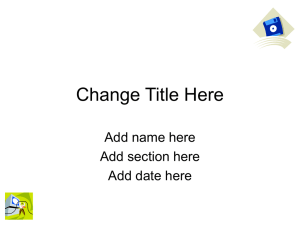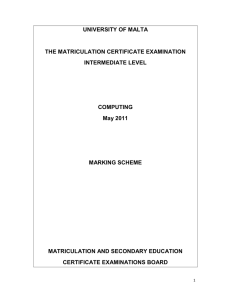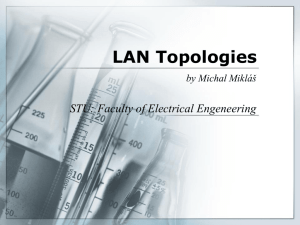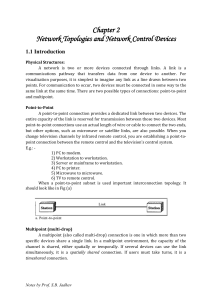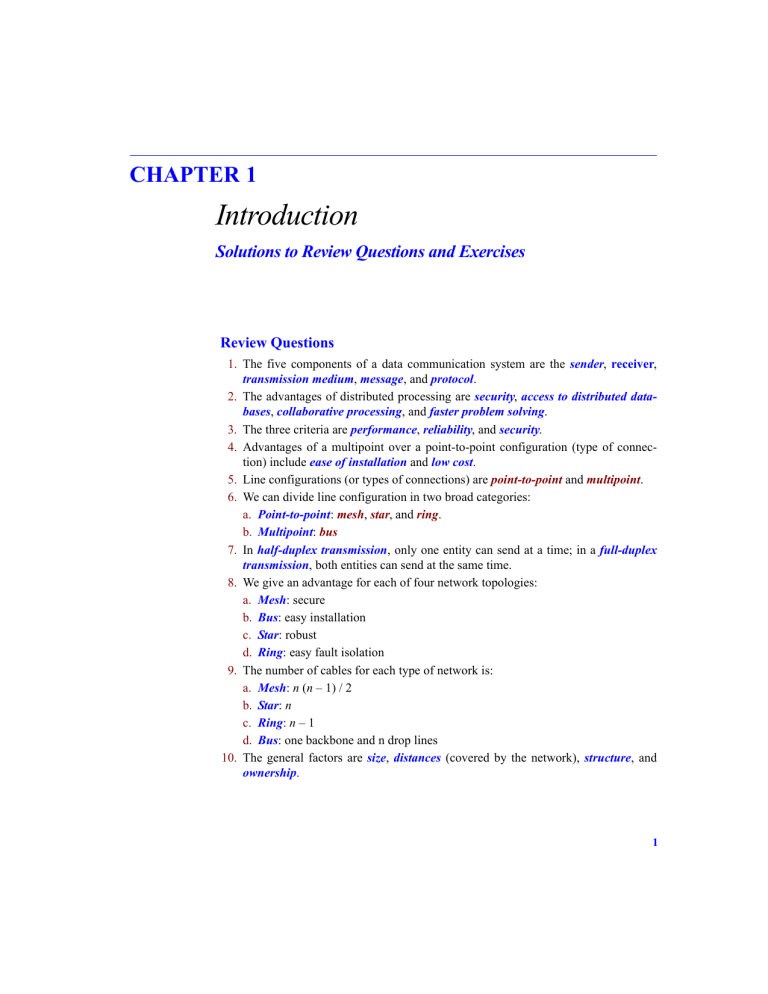
CHAPTER 1 Introduction Solutions to Review Questions and Exercises Review Questions 1. The five components of a data communication system are the sender, receiver, transmission medium, message, and protocol. 2. The advantages of distributed processing are security, access to distributed databases, collaborative processing, and faster problem solving. 3. The three criteria are performance, reliability, and security. 4. Advantages of a multipoint over a point-to-point configuration (type of connection) include ease of installation and low cost. 5. Line configurations (or types of connections) are point-to-point and multipoint. 6. We can divide line configuration in two broad categories: a. Point-to-point: mesh, star, and ring. b. Multipoint: bus 7. In half-duplex transmission, only one entity can send at a time; in a full-duplex transmission, both entities can send at the same time. 8. We give an advantage for each of four network topologies: a. Mesh: secure b. Bus: easy installation c. Star: robust d. Ring: easy fault isolation 9. The number of cables for each type of network is: a. Mesh: n (n – 1) / 2 b. Star: n c. Ring: n – 1 d. Bus: one backbone and n drop lines 10. The general factors are size, distances (covered by the network), structure, and ownership. 1 2 11. An internet is an interconnection of networks. The Internet is the name of a specific worldwide network 12. A protocol defines what is communicated, in what way and when. This provides accurate and timely transfer of information between different devices on a network. 13. Standards are needed to create and maintain an open and competitive market for manufacturers, to coordinate protocol rules, and thus guarantee compatibility of data communication technologies. Exercises 14. Unicode uses 32 bits to represent a symbol or a character. We can define 232 different symbols or characters. 15. With 16 bits, we can represent up to 216 different colors. 16. a. Cable links: n (n – 1) / 2 = (6 × 5) / 2 = 15 b. Number of ports: (n – 1) = 5 ports needed per device 17. a. Mesh topology: If one connection fails, the other connections will still be working. b. Star topology: The other devices will still be able to send data through the hub; there will be no access to the device which has the failed connection to the hub. c. Bus Topology: All transmission stops if the failure is in the bus. If the drop-line fails, only the corresponding device cannot operate. d. Ring Topology: The failed connection may disable the whole network unless it is a dual ring or there is a by-pass mechanism. 18. This is a LAN. The Ethernet hub creates a LAN as we will see in Chapter 13. 19. Theoretically, in a ring topology, unplugging one station, interrupts the ring. However, most ring networks use a mechanism that bypasses the station; the ring can continue its operation. 20. In a bus topology, no station is in the path of the signal. Unplugging a station has no effect on the operation of the rest of the network. 21. See Figure 1.1 22. See Figure 1.2. 23. a. E-mail is not an interactive application. Even if it is delivered immediately, it may stay in the mail-box of the receiver for a while. It is not sensitive to delay. b. We normally do not expect a file to be copied immediately. It is not very sensitive to delay. c. Surfing the Internet is the an application very sensitive to delay. We except to get access to the site we are searching. 24. In this case, the communication is only between a caller and the callee. A dedicated line is established between them. The connection is point-to-point. 3 Figure 1.1 Solution to Exercise 21 Hub Station Repeater Station Station Station Station Repeat er Repeat er Station Station Station Station Figure 1.2 Solution to Exercise 22 Station Station Repeater Repeater Station Station 25. The telephone network was originally designed for voice communication; the Internet was originally designed for data communication. The two networks are similar in the fact that both are made of interconnections of small networks. The telephone network, as we will see in future chapters, is mostly a circuit-switched network; the Internet is mostly a packet-switched network. 4

